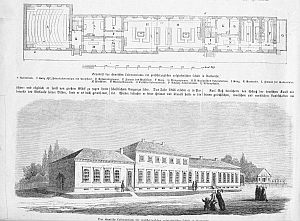150 years ago, chemists from German, England, and overseas met at Karlsruhe for the first international specialized congress on chemistry worldwide. Now, the World Congress of Chemistry returns. It will be organized by the KIT Department of Chemistry and Biosciences on September 3 and 4. On the occasion of this anniversary, the KIT library will exhibit selected contemporary standard works of chemistry and publications of congress participants.
In the middle of the 19th century, chemistry had just formed as a scientific discipline. “There were new discoveries and new analytical methods, which gave rise to competing theoretical schools,” explains Dr. Michael Mönnich from the KIT library, who has conceived and designed the exhibition. In particular, opinions on the atomic and molecular structure varied. The nomenclature and use of formulas also were highly heterogeneous. There was no forum for the discussion of current problems. For this reason, three young professors of chemistry took the initiative and organized the congress.
Carl Weltzien (1813 – 1870) had been appointed to the Polytechnical School in Karlsruhe in 1841, where he headed the Chemical Department from 1850. In 1851, he built the chemical laboratory at the place, where the Tulla-Hörsaal of KIT is today. Together with
Friedrich August Kekulé von Stradonitz (1829 – 1896), professor of chemistry at the University of Gent in Belgium, and Charles Adolphe Wurtz (1817 – 1884) professor in Paris, he invited the most important representatives of his discipline to come to Karlsruhe from September 3 to 5, 1860. “The favorable location of the city played an important role,” says Mönnich.
The meeting took place at the large assembly hall of the Karlsruhe Ständehaus, Ritterstraße, and was supported by the Baden Ministry of the Interior. 127 chemists from 12 countries came, among them famous personalities like Robert Bunsen (1811 – 1899), Carl Remigius Fresenius (1818 – 1897), Jean-Baptiste Dumas (1800 – 1884) or Lothar Meyer (1830 – 1895). “The Karlsruhe congress of chemists may be deemed the most important event in the history of chemistry in the mid of the 19th century,” says Michael Mönnich. According to him, the meeting of so many chemists from Germany and abroad influenced further development of theoretical chemistry and above all the design of the periodic table of the elements.
The exhibition will present important publications of that time: The “Lehrbuch der Chemie” by Jöns Jacob von Berzelius, the atomic model of John Dalton in his “new system of chemical philosophy”, or the “Chemisches Journal für die Freunde der Naturlehre, Artzneygelahrtheit, Haushaltskunst und Manufacturen,” the first chemical journal founded by Lorenz Friedrich von Crell. A detailed look on the contents of the books presented is possible on the internet, where the publications can be found in digitized form.
The colloquium on the occasion of the 150th anniversary of the World Congress of Chemistry on September 3 and 4 at the Audimax (building 30.95, Straße am Forum 1) of KIT will focus on the progress and challenges of chemistry today. Among the lecturers will be the Noble Prize laureates Paul J. Crutzen and Jean-Marie Lehn.
Being “The Research University in the Helmholtz Association”, KIT creates and imparts knowledge for the society and the environment. It is the objective to make significant contributions to the global challenges in the fields of energy, mobility, and information. For this, about 10,000 employees cooperate in a broad range of disciplines in natural sciences, engineering sciences, economics, and the humanities and social sciences. KIT prepares its 22,800 students for responsible tasks in society, industry, and science by offering research-based study programs. Innovation efforts at KIT build a bridge between important scientific findings and their application for the benefit of society, economic prosperity, and the preservation of our natural basis of life. KIT is one of the German universities of excellence.

